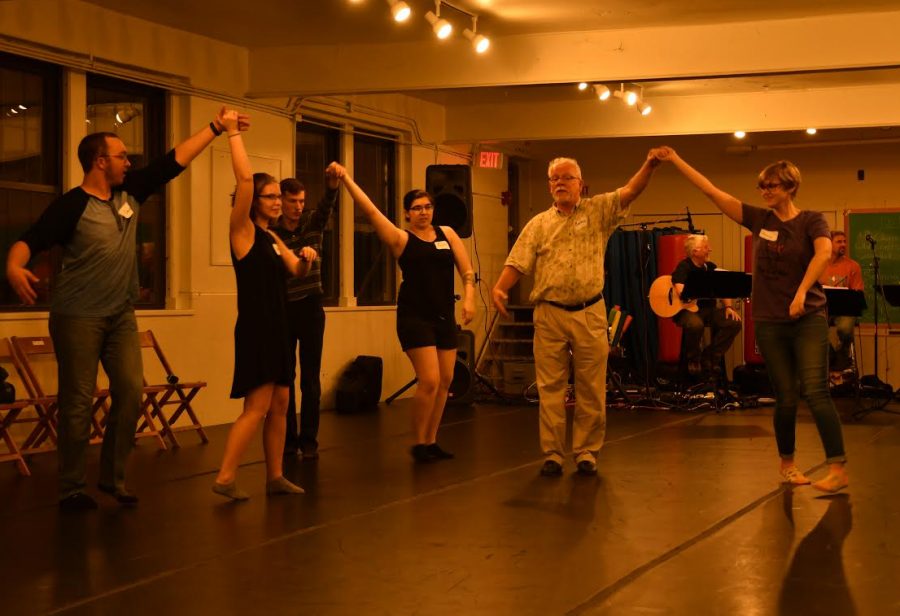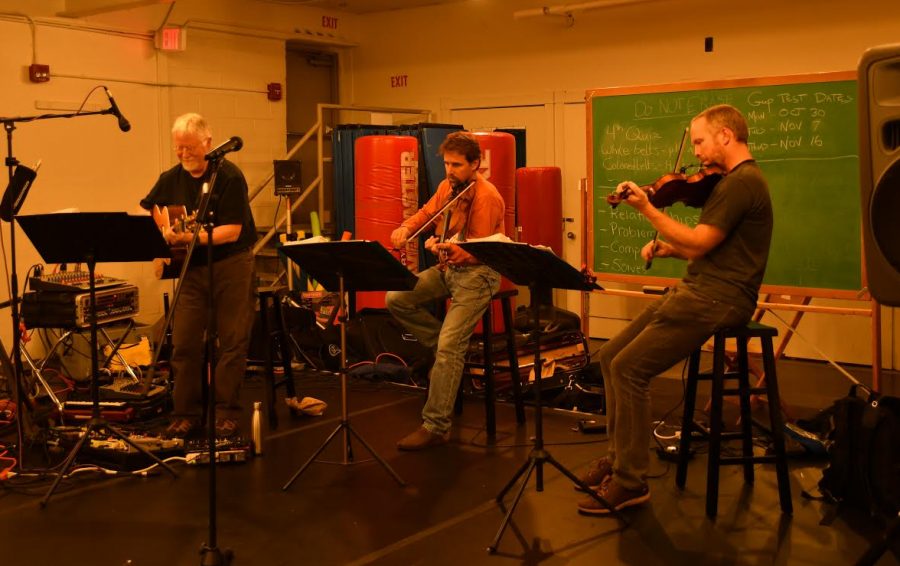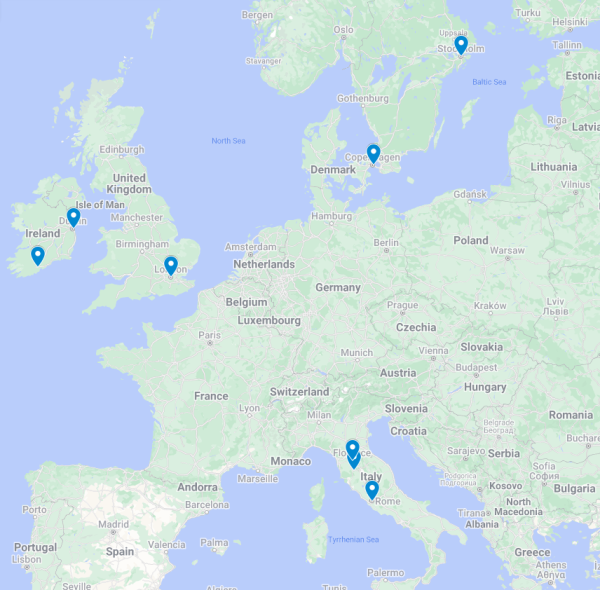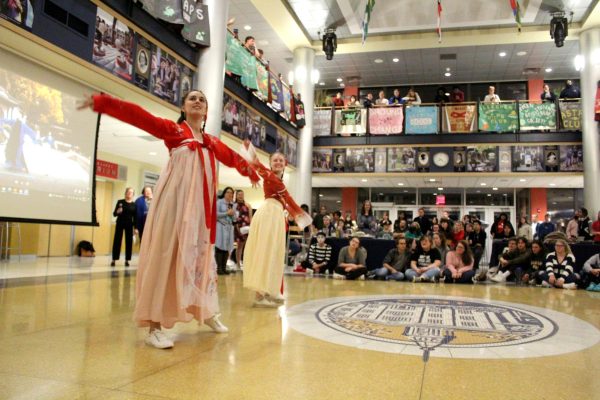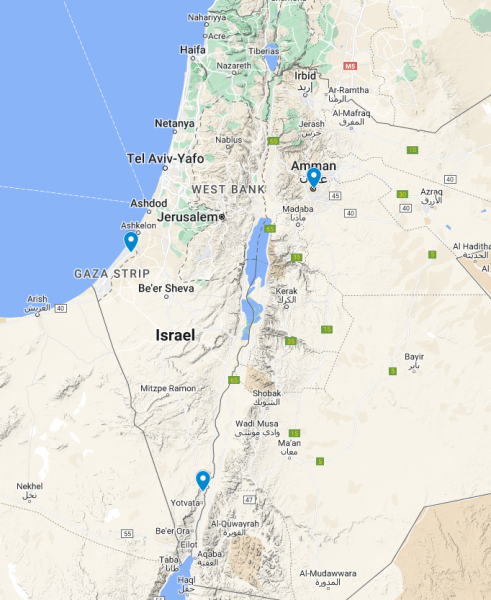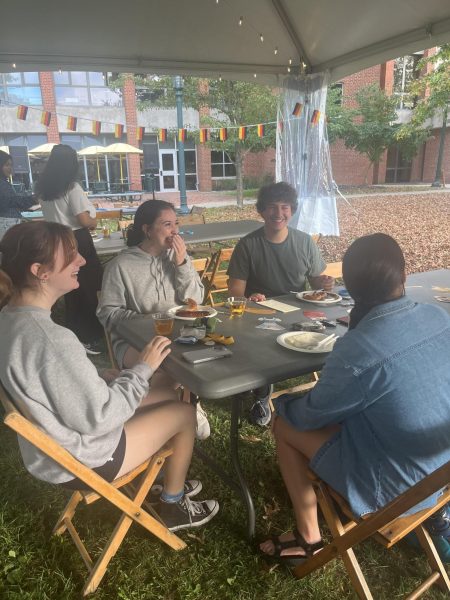Communities gather at monthly contra dance
Brian How of Edinboro provides a waltz lesson to Allegheny College students at the contra dance in Montgomery Hall on Oct. 28, 2017.
Join hands and circle right, right-hand star, one, two, three, four…
Fifteen years ago, Dance and Movement Studies 112: Community Contra Dance was established as a dance and movement studies course in which students and community members gathered weekly to experience contra, according to Rachel O’Brien, associate professor of geology and adjunct instructor for the dance and movement studies program.
O’Brien said the course was offered every semester for 15 years until the 2017 spring semester, when the dance and movement studies program faculty decided to take a break from the course to offer monthly contra dances on Saturday evenings instead. These monthly events feature live music provided by TOPPISH, a local dance band, and typically see between 20 and 30 people in attendance, according to O’Brien.
This month’s contra dance event took place on Saturday, Oct. 28 and brought eight people to the lower studio of Montgomery Hall and out of the weekend rain. The event did not feature any contra dancing because of the low turnout and the need for more than eight dancers in contra, but those eight students and community members stayed for over two hours, danced the waltz and listened to the live music of TOPPISH.
O’Brien serves as the contra dance caller for TOPPISH which means she calls out the steps for the dancers.
“A lot of people think it’s either like square dancing or country line dancing, and it’s not really either of those,” O’Brien said. “[Contra] has some elements of each of them. There’s a half an hour lesson before hand, so you don’t have to have experience, and you don’t have to come with a partner. In fact, it’s uncommon that you dance with the same person all night long.”
O’Brien described the contra at Allegheny as more traditional — with the live band playing Irish and Scottish music. Other styles of contra dance, techno contra for instance, are more modern and are often accompanied by a DJ and a disco ball, O’Brien said.
“It has a really rich history in the sense that it came to this country from British, French and Irish immigrants, so it’s been a folk dance form that’s been evolving for 200 years, which is kind of exciting,” O’Brien said.
Whatever the style, contra dance is really about community and providing a gender fluid space for people of all ages to dance, O’Brien said.
Troy Dinga, ’18, took the the 112 course in the fall 2016 semester and had some stage experience but had never taken a dance class before the contra course.
“It’s an environment where there’s a lot more emphasis on what people have in common as opposed to what separates the people that come,” Dinga said. “You’re not going to get called out or pushed out of a dance because you don’t know what’s going on.”
Eleanor Weisman, associate professor and director of the dance and movement studies and community and justice studies programs, also said dancers at contra events tend to be understanding and supportive when someone makes a mistake.
Allegheny’s contra events allow students and community members to make mistakes and dance together, according to Weisman.
“It’s one of those things that bridges gulfs, it brings people together in a really beautiful way,” Weisman said.
Five students and three community members attended the October contra dance in addition to O’Brien and three members of TOPPISH.
Brian How, an English as a second language instructor at Gannon University in Erie, moved to the area in 2001 and is now a regular participant in local contra events. At the October event, How said he first learned about contra when he was living in Los Angeles, and a friend took him to a contra dance in South Pasadena, California.
“It was beautiful,” How said. “It took a little while to get used to, but I liked it a lot.”
How, who now lives in Edinboro, said he has since been to contra dances in Vermont, New Jersey and Washington D.C. The band at Allegheny’s events, though, is something special, according to How.
“Some contra dance bands like to dip into other styles, but these are Irish and Scottish reels and jigs,” How said. “This is a cultural treasure for the area, they’re lovely.”
TOPPISH, organized by guitar and flute player Jack Lindberg, enjoys playing specifically for dancers.
“You get really good energy from the people you’re playing for,” said fiddle player Michael Hurley. “There’s a lot of immediate feedback.”
Even though contra was deferred until the November event, the band filled the studio space with energetic Irish and Scottish melodies and even played some waltz as How provided an impromptu waltz lesson at the request of the Allegheny students there.
Weisman said events like the contra dances provide an opportunity for students interested in dance to learn and progress in their own time.
“For me as a dance educator, I think a lot of people don’t consider themselves dancers,” Weisman said. “People will come up to me and say, ‘Oh you’re so lucky you get to dance.’ Well in my mind, dance is a human activity. In a contra dance, you’ll see little kids and adults and we’ll all be dancing together, it sort of levels the playing field as to who can be considered a dancer.”
The next contra dance will be held in the lower studio of Montgomery Hall on North Main Street on Nov. 18 with a lesson beginning at 7:15 p.m. The event is free for college and high school students and $10 for adults.



